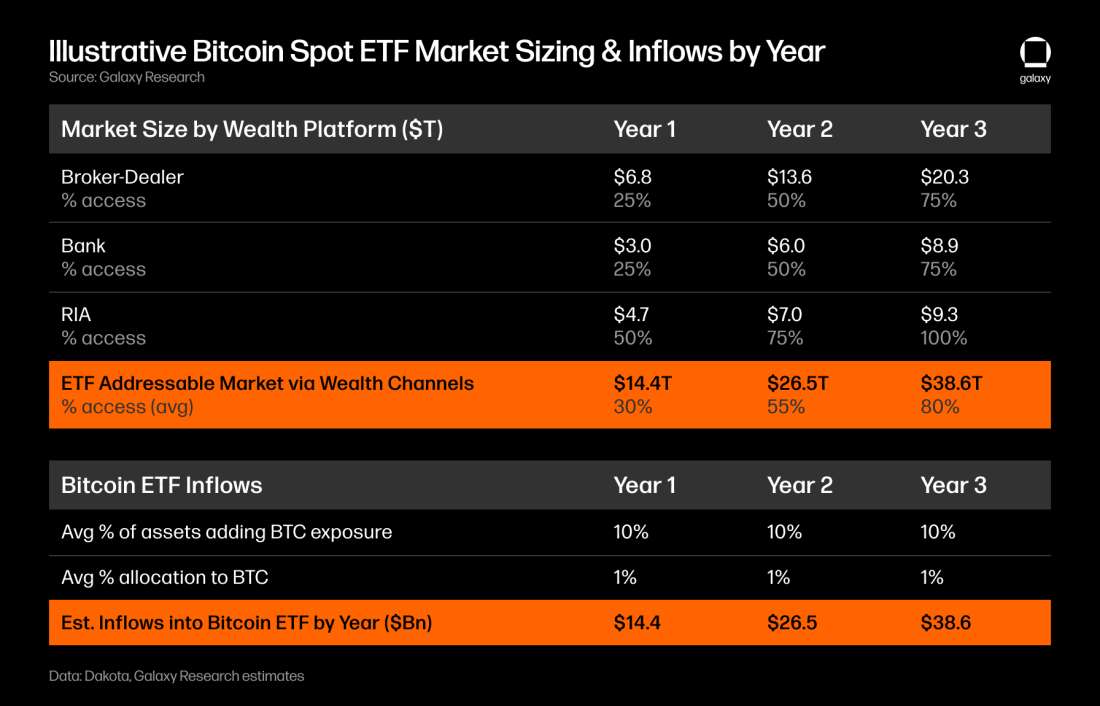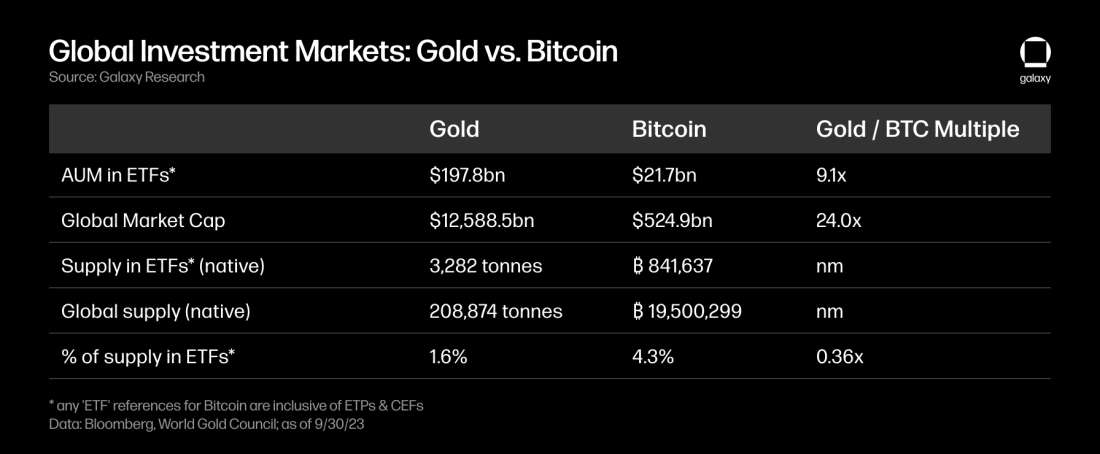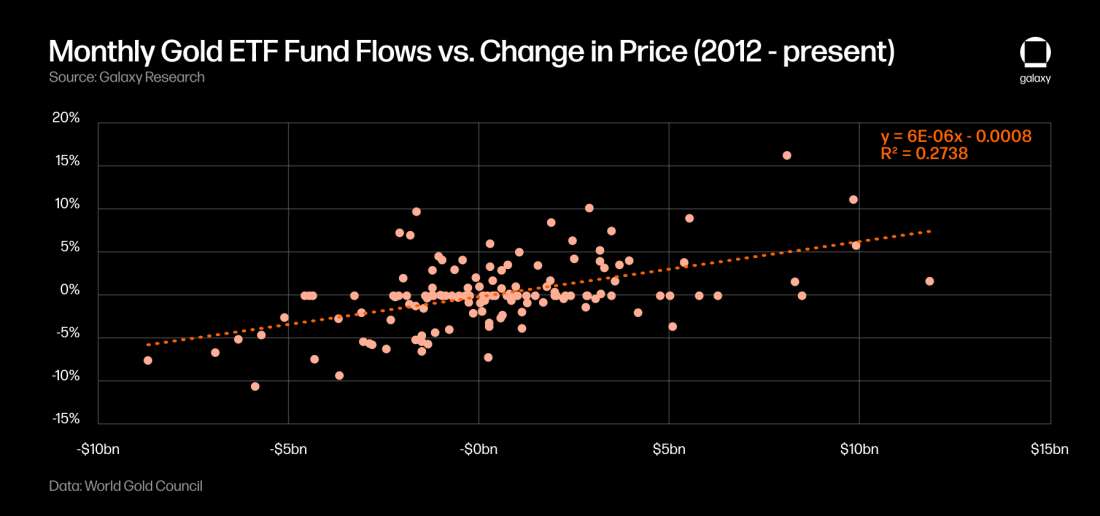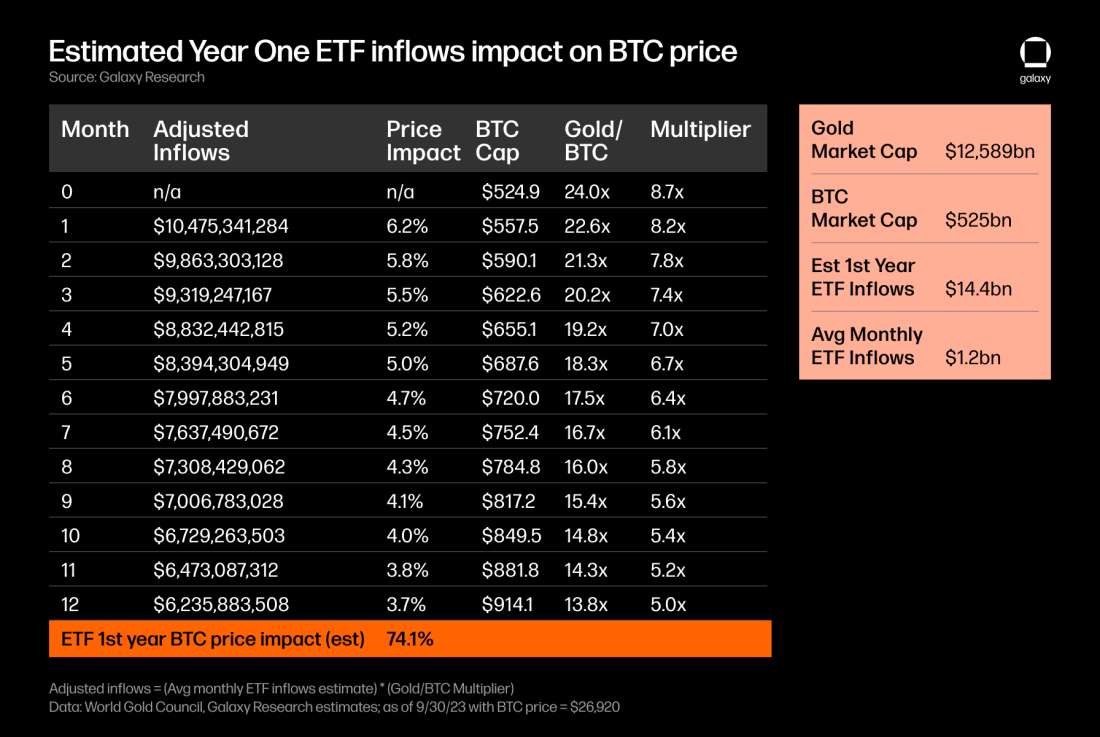Sizing the Market for a Bitcoin ETF

Approval for a US-regulated spot Bitcoin ETF will be one of the most impactful catalysts for the adoption of Bitcoin (and crypto as an asset class).
Significance of a Bitcoin ETF
Why Bitcoin ETF is a more ideal solution than current investment vehicles
As of 9/30/23, the amount of BTC held in bitcoin investment products (incl. ETPs and closed-end funds) totaled 842k (~$21.7 billion).

These Bitcoin investment products come with significant drawbacks for investors – aside from the high fees, low liquidity, and tracking error, these products are inaccessible to a wide investor population representing a significant portion of wealth. Alternative investment options to add indirect exposure to bitcoin (e.g., equities, HFs, futures ETFs) also have similar tracking inefficiencies. And many investors would prefer to not deal with the administrative burden from owning bitcoin directly, which involves wallet / private key management with self-custody and tax reporting.
A spot ETF could be suited for any investor that wants direct exposure to bitcoin without having to own and manage the bitcoin through self-custody, offering numerous benefits over current bitcoin investment products and options such as:
Greater efficiencies through fees, liquidity, and price tracking. While fees haven’t been listed by bitcoin ETF applicants yet, ETFs generally offer lower fees compared to hedge funds or closed-end funds and the high number of ETF applicants will likely aim to keep fees low to remain competitive. A spot ETF would also offer enhanced liquidity as it is traded on major exchanges and better price tracking compared to futures-products or proxies to obtain exposure to bitcoin.
Convenience. A spot ETF could enable investors to obtain bitcoin exposure through a wider range of channels and platforms, including the established set of providers that investors are already familiar with. It offers an easier on-ramp for both retail and institutional investors compared to direct ownership, which requires a certain level of self-education to onboard and comes with greater administrative costs.
Regulatory compliance. Compared to the existing bitcoin investment products, a spot ETF would likely meet more robust compliance requirements set by regulators around custody setups, surveillance, and bankruptcy protection. In addition, an ETF could offer greater price transparency and discovery for market participants, which may help lower the market volatility of bitcoin.
Why a Bitcoin ETF Will Matter
The two primary factors for why a bitcoin spot ETF could be particularly impactful for the market adoption of bitcoin are: (i) expanded accessibility across wealth segments, (ii) greater acceptance through formal recognition by regulators and trusted financial services brands:
Accessibility
Greater reach for both retail and institutions. The current scope of BTC investment funds available today is limited and includes products that are mostly wealth advisor driven or available via institutional platforms. An ETF is a more direct regulated offering that would increase access for a larger population of investors (incl. retail + affluent individuals). Rather than relying on wealth managers, ETFs can be accessed by a wider scope of clients including directly in brokerage or in RIAs (which prohibit direct purchasing of spot Bitcoin).
Distribution through more investment channels. Financial advisors / fiduciaries cannot consider bitcoin in their wealth management strategies without an approved bitcoin investment solution like a spot ETF. The wealth management segment holds significant capital that has been unable to access bitcoin investments directly through traditional channels – with an approved spot ETF, financial advisors can start to direct their wealth clients to invest in bitcoin.
Greater wealth opportunity. Boomers & earlier (aged 59+) hold 62% of US wealth, yet only 8% of adults age 50+ have invested in crypto vs. 25%+ for adults aged 18-49 (Fed, Pew). Having a bitcoin ETF product offering through familiar, trusted brands could help to attract a larger portion of the older, wealthier population that have not yet been onboarded.
Acceptance
Formal recognition / legitimacy from trusted brands. Bitcoin ETF applications have been filed by a large number of established financial brand names - formal recognition / validation from these mainstream firms can improve perceptions around bitcoin/crypto's legitimacy as an asset class and can attract more acceptance and adoption. According to Pew Research, among the 88% of Americans that have heard of crypto, 75% are not confident in the current ways to invest, trade or use crypto.
Addresses regulatory and compliance concerns; regulatory clarity would attract more investment and development. SEC approval for an ETF could alleviate investors of many of these safety and compliance concerns as a regulated investment product with more comprehensive risk disclosures. It would also provide market participants with long-demanded regulatory clarity to operate in the crypto industry. A more developed regulatory framework would attract more investment and development, improving the competitiveness of the US for the crypto industry.
BTC portfolio benefits / acceptance as an asset class. Bitcoin can provide diversification benefits and enhanced returns in a portfolio, no matter from where in the portfolio the allocation is drawn. (Read our recent report, Bitcoin in a Portfolio). To help guide investment management decisions, more retail investors and financial advisors have been turning more towards model portfolios and automated solutions, which have increasingly used ETFs and incorporated alternative asset classes to provide more risk-optimized returns for investors. A longer track record can support the case for bitcoin in a portfolio to be used across more investment strategies.
Estimating Inflows from Bitcoin ETF approval
Given the accessibility reasons mentioned above, the US wealth management industry will likely be the most addressable and direct market that would have the most net new accessibility from an approved Bitcoin ETF. As of October 2023, assets managed by broker-dealers ($27T), banks ($11T) and RIAs ($9T) collectively totaled $48.3 trillion.

We apply the $48.3T across selected US wealth management aggregators as a baseline TAM in our analysis (excluding the family office channel which manages ~$2T), though the addressable markets of a Bitcoin ETF and the indirect reach/impact of a Bitcoin ETF approval are likely to extend far beyond the US wealth management channel (e.g., international, retail, other investment products, and other channels) and will potentially attract far greater inflows into Bitcoin spot markets and investment products.
(Note: Although we apply a TAM-style analysis to estimate inflows into a bitcoin ETF, we acknowledge that the flows into a bitcoin ETF may also drive net new inflows rather than simply diverting from existing allocations – therefore, applying % capture assumptions to an estimated TAM figure does not fully reflect our view for how a bitcoin ETF could be adopted since it does not capture this new stream of demand.)
The access ramp cycle for a Bitcoin ETF across each of these segments will likely span several years as the channels open up access. The RIA channel, comprised primarily of independent registered investment advisors who are sophisticated in nature, will potentially allow access sooner than advisors affiliated with banks and broker dealers, hence a larger initial accessibility share in our analysis. For the banks and broker-dealer channels, each individual platform will decide when to unlock access to a Bitcoin ETF product for their advisors – outside of some exceptions, financial advisors affiliated with banks and b/ds cannot offer/recommend specific investment product(s) unless approved by the platform. Platforms may have specific requirements before they can provide access to new investment products (e.g., track record > 1-year or AUM above a certain amount, general suitability concerns, etc.), which will impact the access ramp cycle.
We assume that the RIA channel will ramp up starting at 50% in Year 1 and increasing to 100% in Year 3. For the broker-dealers and bank channels, we assume a slower ramp starting at 25% in Year 1 with a steady increase to 75% in Year 3. Based on these assumptions, we estimate the addressable market size of a U.S. Bitcoin ETF to be ~$14T in Year 1 after launch, ~$26T in Year 2, and $39T in Year 3.

Estimating inflows into Bitcoin ETFs: Based on these market size estimates, if we assume that BTC is adopted by 10% of total available assets in each wealth channel with an average allocation of 1%, we estimate $14bn of inflows into a Bitcoin ETF in the first year following an ETF launch, ramping up to $27bn by the second year and $39bn by the third year post-launch. Of course, if Bitcoin spot ETF approvals are delayed or denied, our analysis would be altered by timing and access restriction. Or if poor price performance, or any other factor, leads to lower-than-expected access or adoption to a bitcoin ETF, our estimates could prove too aggressive. On the other hand, we believe our assumptions on access, exposure, and allocation are conservative, so inflows could also be higher than expected.
Potential Impact on BTCUSD
As of 9/30/23, Gold ETFs collectively hold ~3,282 tonnes (~$198bn in AUM) globally, representing ~1.7% of the gold supply, according to World Gold Council data.
As of 9/30/23, bitcoin held in investment products (incl. ETPs and closed-end funds) totaled 842k BTC (~$21.7bn in AUM), representing 4.3% of total issued supply.

With gold having an estimated ~24x larger market capitalization and 36% less supply held in investment vehicles compared to bitcoin, we assume a dollar-equivalent amount of fund inflows having a ~8.8x greater impact on bitcoin markets compared to gold markets.
If we apply our year-one estimate of $14.4bn in inflows (~$1.2bn per month or ~$10.5bn on an adjusted-basis using our 8.8x multiplier) into the historical relationship between gold ETF fund flows & change in gold price, we estimate a +6.2% price impact for BTC in the first month.

Holding the inflows constant but adjusting the multiplier downwards each month for the change in the gold / BTC market cap ratio from BTC price increases, we could see monthly returns gradually ramping down from +6.2% in the first month to +3.7% by the last month of the first year, resulting in an estimated +74% increase in BTC in the first year of an ETF approval (using 9/30/23 BTC price $26,920 as the starting point).

The broader financial impact of an ETF for the Bitcoin market
The above analysis estimates the potential inflows into a US Bitcoin ETF product. However, there will likely be a much larger impact on BTC demand from second-order effects of a bitcoin ETF approval.
In the near-term, we expect other global / international markets to follow the US in approving + offering similar bitcoin ETF offerings to a wider population of investors. In addition to ETF offerings, a wide range of other investment vehicles are likely to add bitcoin to their strategies (e.g., mutual funds, closed-end, and private funds, etc.) – across investment objectives and strategies. For example, Bitcoin exposure could be added by alternative funds (e.g., currency, commodity & other alts) and thematic funds (e.g., disruptive tech, ESG & social impact). (See our report The Impact & Opportunity of Bitcoin in A Portfolio for an examination of different bitcoin allocation strategies.)
Longer-term, the addressable market for bitcoin investment products could extend even further across all third-party managed assets (~$126T in AUM according to McKinsey) and even more broadly across global wealth ($454T according to UBS). Some believe that as Bitcoin monetizes, it will systematically reduce the monetary premium applied to other assets like real estate or precious metals, dramatically expanding Bitcoin’s TAM.
Based on these market sizes and keeping our adoption/allocation assumptions the same (BTC adopted by 10% of funds at an average allocation of 1%), we estimate potential new incremental inflows into Bitcoin investment products ranging from ~$125bn to ~$450bn over an extended period.

Summary & Conclusion
Applicants have sought to list a spot-based Bitcoin ETF for a decade. During that time, Bitcoin’s market capitalization has risen from less than $1bn to $600bn today (and it reached as high as $1.27tn in 2021). The ownership and use of Bitcoin around the world has risen dramatically in that time, with many different types of wallets, crypto-native exchanges and custodians, and traditional market access vehicles around the world. But the world’s biggest capital market, the United States, still lacks the most efficient market access vehicle for Bitcoin – a spot-based ETF. Anticipation that ETFs will be approved soon is rising, and our analysis suggests these products could see significant inflows, primarily driven by the wealth management channels that cannot currently access safe and efficient bitcoin exposure at scale.
Inflows from ETFs, market narratives about the forthcoming Bitcoin halving (April 2024), and the possibility that rates have peaked or will peak in the near term, all suggest that 2024 could be a big year for Bitcoin.
Legal Disclosure:
This document, and the information contained herein, has been provided to you by Galaxy Digital Holdings LP and its affiliates (“Galaxy Digital”) solely for informational purposes. This document may not be reproduced or redistributed in whole or in part, in any format, without the express written approval of Galaxy Digital. Neither the information, nor any opinion contained in this document, constitutes an offer to buy or sell, or a solicitation of an offer to buy or sell, any advisory services, securities, futures, options or other financial instruments or to participate in any advisory services or trading strategy. Nothing contained in this document constitutes investment, legal or tax advice or is an endorsementof any of the digital assets or companies mentioned herein. You should make your own investigations and evaluations of the information herein. Any decisions based on information contained in this document are the sole responsibility of the reader. Certain statements in this document reflect Galaxy Digital’s views, estimates, opinions or predictions (which may be based on proprietary models and assumptions, including, in particular, Galaxy Digital’s views on the current and future market for certain digital assets), and there is no guarantee that these views, estimates, opinions or predictions are currently accurate or that they will be ultimately realized. To the extent these assumptions or models are not correct or circumstances change, the actual performance may vary substantially from, and be less than, the estimates included herein. None of Galaxy Digital nor any of its affiliates, shareholders, partners, members, directors, officers, management, employees or representatives makes any representation or warranty, express or implied, as to the accuracy or completeness of any of the information or any other information (whether communicated in written or oral form) transmitted or made available to you. Each of the aforementioned parties expressly disclaims any and all liability relating to or resulting from the use of this information. Certain information contained herein (including financial information) has been obtained from published and non-published sources. Such information has not been independently verified by Galaxy Digital and, Galaxy Digital, does not assume responsibility for the accuracy of such information. Affiliates of Galaxy Digital may have owned or may own investments in some of the digital assets and protocols discussed in this document. Except where otherwise indicated, the information in this document is based on matters as they exist as of the date of preparation and not as of any future date, and will not be updated or otherwise revised to reflect information that subsequently becomes available, or circumstances existing or changes occurring after the date hereof. This document provides links to other Websites that we think might be of interest to you. Please note that when you click on one of these links, you may be moving to a provider’s website that is not associated with Galaxy Digital. These linked sites and their providers are not controlled by us, and we are not responsible for the contents or the proper operation of any linked site. The inclusion of any link does not imply our endorsement or our adoption of the statements therein. We encourage you to read the terms of use and privacy statements of these linked sites as their policies may differ from ours. The foregoing does not constitute a “research report” as defined by FINRA Rule 2241 or a “debt research report” as defined by FINRA Rule 2242 and was not prepared by Galaxy Digital Partners LLC. For all inquiries, please email [email protected]. ©Copyright Galaxy Digital Holdings LP 2023. All rights reserved.


